Agricultural and Biological Research
RNI # 24/103/2012-R1
Research Article - (2023) Volume 39, Issue 1
The paper focuses on the traditional usage of aquatic plants found in the wetland areas of the Imphal valley of Manipur. From the survey, 30 aquatic plants have been collected for use in the management of various health conditions. Most of the collected plants are consumed as daily food items, but some are used for specific remedial purposes in the treatment of certain types of ailments and diseases like cough, fever, ulcer, piles, diarrhoea, jaundice, skin diseases, rheumatic pain, diabetes, hypertension, urinary troubles, body pain, respiratory problems, urinary problems, cardiovascular diseases, etc. Accordingly, different parts of the plant are used as a single item or by mixing with other ingredients in various forms, such as fresh or raw, culinary, or as a tonic, in dry or powder form, to treat the diseases. The aquatic plants are also incorporated in the preparation of various traditional dishes. 70% of collected wetland plants are marketable, providing a means of livelihood and a source of income for the poor and needy. Therefore, proper documentation and the preservation of traditional knowledge are essential and may provide useful information for future generations through research in pharmaceuticals and drug discovery.
http://www.environmentjournals.com/
http://www.eventsupporting.org/
http://www.escientificreviews.com/
http://www.openaccesspublications.com/
http://www.imedpub.org/
http://www.jpeerreview.com/
http://www.escientificres.com/
http://www.scholarlyjournals.org/
http://www.eclinicaljournals.com/
http://www.scischolarsjournal.com/
http://www.intlscholarsjournal.com/
http://www.scholarsresjournal.com/
http://www.sysrevpharma.org/
http://www.environjournal.com/
http://www.jpeerres.com/
http://www.managjournal.org/
http://www.emedicalhub.org/
http://www.biomedresj.org/
http://www.aaccongress.com/
http://www.eclinicalres.org/
http://www.scholarlymed.com/
http://www.eclinicalres.com/
http://www.theresearchpub.com/
http://www.imedpubscholars.com/
http://www.scholarcentral.org/
http://www.journalpublications.org/
http://www.scholarlypub.com/
http://www.imedpublishing.org/
http://www.emedsci.com/
http://www.longdomjournals.org/
http://www.longdomjournal.org/
http://www.emedicalcentral.com/
http://www.lexisjournal.com/
http://www.geneticjournals.com/
http://www.scitecjournals.com/
http://www.microbialjournals.org/
http://www.engjournals.org/
http://www.eneurologyjournals.com/
http://www.pulsusjournal.org/
http://www.biochemjournal.org/
http://www.epharmacentral.com/
http://www.eclinicalsci.com/
http://www.eclinicalcentral.com/
http://www.eclinmed.com/
http://www.jopenaccess.org/
http://www.peerreviewedjournals.com/
http://www.immunologyjournals.com/
http://www.neurologyjournals.org/
http://www.clinicalmedicaljournals.com/
http://www.molecularbiologyjournals.com/
http://www.geneticsjournals.com/
http://www.biochemistryjournals.org/
http://www.psychiatryjournals.org/
http://www.pharmajournals.org/
http://www.alliedresearch.org/
http://www.medicalres.org/
http://www.medicalresjournals.com/
http://www.alliedsciences.org/
http://www.pediatricsjournals.org/
http://www.oncologyinsights.org/
Aquatic plants; Traditional usage; Wetlands; Pharmaceuticals
Wetlands are “wealthlands” or “biological supermarkets” because of the extensive food chain and rich biodiversity that they support [1]. They are one of the most biologically productive ecosystems on Earth and provide numerous services to human civilization [2]. Wetlands are lands that are transitional between terrestrial and aquatic systems [3] and consist of lakes, rivers, bogs and marshes. It is the area of land that remains waterlogged for a substantial period of the year. Wetlands in India comprise less than 5% of the total geographical region, and they are the most productive biomes that support one-fifth of the total biodiversity [4,5]. The Indian landscape is prominent for its 4290 large lakes and numerous small water bodies [5,6]. Northeast India falls under the Indo-Burma global hotspot, and the area harbours a maximum number of wetlands [7]. The wetlands of northeast India have a rich diversity of habitats consisting of lakes, reservoirs, bells, rivers, ponds, etc., and are one of the most productive life-supporting systems, having immense socio-economic and ecological importance to the people of the region [8,9]. Loktak Lake (Manipur), Deepor Beel (Assam), Rudrasagar (Tripura), Palak, and Tamdil (Mizoram) are a few of the freshwater wetlands of the region known for their resources [10,11]. Manipur is a state that consists of several lakes, marshes, swamps, canals (24,804 ha), rivers and streams (13,888 ha), and low-lying wetlands (9,219 ha) that cover a total area of 47,911 ha. Among the 13 lakes (wetlands) found in Manipur, Loktak Lake (42,672 ha) is the biggest and is one of the Ramsar sites of global significance [12,13]. The districts of Imphal and Thoubal have the most lakes. However, there are also several smaller lakes known as kom (pits). In different areas of Manipur, there are around 134 waterlogged swamps and marshes. These areas are low-lying, situated either in the peripheral areas or the vicinity of the lakes. The maximum number of areas covered with water is recorded in the Imphal Valley (69), followed by Thoubal (40) and Bishnupur districts (21). There are two artificial reservoirs, one each in Senapati and Tamenglong districts [14,15]. More than 30 ethnic communities totalling approximately 23 lakh people, live in various parts of the state, relying primarily on their cumulative knowledge and surrounding resources for their day-to-day healthcare [12]. In addition to providing food and medicine, they maintain the livelihood and income of an extensive segment of people living around them [5]. Wetland areas are also abundant in medicinal plants, which aid in the treatment of a variety of ailments and diseases. Since time immemorial, the application of traditional medicine has not only helped in conserving their traditional knowledge but also in the management of health and diseases. From this, we can say that the practise of ethnomedicine is a vehicle for understanding indigenous societies and their relationship with nature. The rapid decline in usage, ignorance, changes in climate, environment, and advancements in pharmaceutical medicines have posed a threat to their practices. As a result, proper documentation of aboriginal knowledge is critical which we can achieve through ethnobotanical studies in biological resource conservation and management. The documentation of aquatic plants will facilitate future research on the safety and efficacy of different ailments. In addition, insufficient data are available specifically on ethnobotanical reports of aquatic plants in Manipur. And it is also revealed that aquatic plants have a higher concentration of bioactive compounds because of their ability to adjust to intense environmental conditions like alkaline, or acidic water, high or low temperature, high pressure, and an inadequate substrate in the water [16,17]. It will facilitate the discovery of new sources of drugs and promote the sustainable use of aquatic plants. Therefore, considering these points, the present study is focused on the traditional usage of aquatic plants found in the Imphal valley of Manipur.
Study area
Manipur is an isolated hill grit state lying in the extreme north-eastern corner of India along the Indo-Myanmar border. The geographical area consists of about 22,327 square kilometres (8,621 sq mi) [5] and has a population density of 2,855,794 as per the 2011 census. Around 90 percent of the state consists of hilly regions; the remaining is covered by the lacustrine plains of the Central Valley [18]. The current study area includes wetlands in Manipur's Central or Imphal valley (93°42' to 94°11' E and 24°41' to 25°06' N). It is an intermundane basin around 70 km long (north to south) and 30-35 km wide (east to west), oval-shaped with an unequal outline covered by hills. The valley is a high flood plain with an altitude of around 760 m above mean sea level. Several streams and rivers arising from the hills are the main physiological features of the valley, and many shallow wetlands and marshes are in the interfluvial areas. The Imphal River is the most significant perennial river flowing in the Central Valley of Manipur and its tributaries (Iril, Thoubal, Khuga, Sekmai, Chakpi, etc.). Other small rivers (Nambul, Nambol, Kongba, Merakhong, etc.) dried out throughout the lean period [1,18].
The lacustrine plains of the Central Valley were the site of an ancient lake that was later filled up and uplifted to its current position, the remnant of which is the Loktak Lake, which occupies the south-east corner of the valley [19]. Several lakes surround the Imphal River on both sides. The biggest river Loktak, has stayed on the right side of the Imphal River; on the left side are the Ikoppat/Kharungpat, Waithoupat, Khoidumpat, Lamjaopat, and Pumlenpat. During the rainy season (May to August), most of these lakes become contiguous; however, during the dry season, they are merged under a massive sheet of water. Ikoppat/Kharungpat, Waithoupat, Utrapat, Poiroupat, Sanapat, Loushipat, and Ushoipokpipat are all extremely old eutrophic and seasonal marshy land areas [1].
Methods
The collection of data for the study has been done based on both primary and secondary sources. The data was accumulated through primary sources by surveying all the wetlands and conducting a comprehensive survey of Loktak and Pumlen lakes situated in the Central Valley of Manipur. Information was gathered through questionnaire interviews to better understand the various uses of the lake's features. The information regarding traditional usage was gathered through an extensive survey (2018-2019), semi-structured interviews, and focus group discussions. A total of 200 individuals (30-70 years old) were questioned together with village chiefs, priests, senior leaders, and local healers (Maibas and Maibis) identified with the assistance of local administrators and community leaders. Field visits involved direct contact with the community and also visiting the Ema market (local market), the nearest and biggest market in Manipur. Around 10-15 women vendors in the Ema market were catechized regarding the local name of the plants, uses, source, and medicinal properties. A small number of herbal practitioners/healers (n=10) also visited. During the discussion, information was assembled based on vernacular names, plant parts used, and modes of preparation, administration, and measured doses and elaborately documented for the medication of particular ailments. To obtain accurate data, secondary sources of data from the published works on the aquatic plants of Manipur have also been consulted. Plant specimens secured after regular field trips to the wetlands of Manipur were identified as to their scientific names and families with the help of experts and using standard literature and floras [20-24]. All the literature concerning the wetlands of the state has been interrelated. Efforts have been made to recover accurate data by touring several times for validation. The mineral content of ten of the 30 collected aquatic plants was estimated using standard methods [25]. The ten samples were washed thoroughly under running tap water to make them free from dust and then dried in a shady area at room temperature (25°C) with regular turning. Dried plant parts were then chopped and ground to a coarse powder using an electronic grinder for laboratory analysis [26].
Considering community perception regarding plant use and taste, availability, and conservation status, we aggregated these factors for different aquatic plants using a random sampling method. The community interpretation (n=30) was ranked from least to most preferred on a scale of 1 to 4. For assessing "use" and "taste" status, the ranking was done with the community members as "4-most preferred", "3-commonly preferred", "2-preferred but not so common", and "1-occasionally used". For "Availability’ status, the species was ranked based on field observations by the authors, market availability trends, and interactions with collectors and user groups as "4-extensively available", "3-commonly available", "2-available but not so common", and "1-rare. The scale ranked "conservation" status as 4 for species whose conservation is highly needed, 3 for species whose conservation is urgently needed, 2 for species whose conservation is required but not urgent, and 1 for species whose conservation is not currently required. Such a ranking of the species was found to be useful in understanding community perceptions of the species use [27].
Data analysis
The mineral content of the ten aquatic plants is given as a mean average (± SD). The data collected on community rankings of aquatic plants for their use, taste, availability, and conservation status was qualitative, which was ranked on a scale of 1 to 4 to convert it to quantitative form. The information was ethnographically analyzed based on community discernment, belief, and thoughts about aquatic plant resources so that management and protection movements can be addressed in the near future.
Yield and yield components performances in potato
The observations made and collected based on traditional usage are presented in Supplementary Table with the botanical names of the plants arranged in alphabetical order followed by their families in parentheses and local names in the Manipuri language. Out of 30 aquatic plants that accumulated in the wetland areas of the central valley of Manipur state, 21 plants were adopted in traditional delicacies such as ootti, eronba, singju, etc. All the aquatic plant species had a common name that explains the prevalent use of these species in the traditional system.
The most commonly consumed aquatic plants are Alocasia cuculata, Cyperus haspan, Enhydra fluctuans, Eryngium foetidum, Euryale ferox, Hedychium coronarium, Houttuynia cordata, Ipomea aquatic, Nelumbo nucifera, Neptunia oleraceae, Oenanthe javanica, Polygonum barbatum, Polygonum posumba, Sagittaria sagittifolia, Trapa natans and Zizania latifolia. Diverse communities used different modes to consume these aquatic plants. Consumption in the form of raw food was the most preferred mode to use these plants and was incorporated into the most commonly eaten traditional preparations, viz., ootti, eronba, singju, etc. The ‘Singju’ was prepared by aquatic plants along with fermented fish, chili, and other plants; the "eronba" was made by boiling plant parts and smashing them with potatoes, chili, and fermented fish before consuming; while the only local dish, ‘ootti’, was prepared by boiling vegetables with a pinch of sodium bicarbonate (Table 1). At least one of these traditional delicacies becomes an essential component of the local diet, explaining the importance of aquatic plants in the local food system.
| Name of the local dish | Preparation |
|---|---|
| Ironba | It is a special dish prepared from several vegetables, viz., Wendlanda (inflorescence), Sagittaria (tuber), Solanum tuberosum, Musa paradasiaca, Amorphophalus sp., Abelmoscus esculentus, etc., boiled together. The fermented fish mash with red chilli and an appropriate amount of salt is mixed with all the other cooked vegetables. Variations include Ipomea aquatica, Oenanthe javanica, Euryale ferox, Trapa natans, Sagittaria sagittifolia, Polygonum barbatum, and others. The finished dish so prepared is garnished with finely chopped Houttuinia cordata (roots, leaves), onion stalks, Elsholtzia blanda (inflorescence), Allium odorum, etc. as condiments to give it a characteristic aroma. |
| Ametpa | It is spicy chutney prepared from boiled, steamed, or fried chilies mixed with fermented fish. Consume the green leaves of Pisum sativum, Brassica campestris, Brassica oleracea, Houttuinia cordata, Polygonum posumba, Polygonum barbatum, Euryale ferox, Ipomea aquatica, Oenanthe javanica, Neptunia oleraceae, etc. |
| Singju | A traditional Meitei salad is prepared from finely chopped raw vegetables like cabbage, onions, lotus stems, tree beans, coriander, Alocasia cuculata, Ipomea aquatic, Oenanthe javanica, etc., mixed with red pepper, sesame seeds, roasted gram flour, salt, boiled seeds of beans or peas, and fermented fish. Dishes can be prepared with raw papaya, cabbage, banana flower, Nelumbo nucifera garnished with Allium odorum, Houttuinia cordata, and so on. |
| Chagem-pomba | A traditional dish prepared for a grand feast Prepare using a combination of various kinds of tender leaves (Neptunia oleraceae, Brassica juncea, Vicia faba, Parkia speciosa, Anethum graveolens, Allium odorum, etc.), ground rice, (chagem), red pepper, dried and fermented fish, fermented soybean, and then cook together. |
| Kangsu | It is a traditional dish similar to singju. It is a side dish made of mashed boiled vegetables and fermented fish with salt and red pepper powder. |
| Ooti | It is a classic traditional dish that is considered a must-have main course at a grand feast. Prepare peas and several green leafy vegetables, with or without grounded rice. It is the only dish prepared with sodium bicarbonate. Amaranthus spinosus, Colocasia esculenta, Clerodendrum Indicum, Brassica oleracea, Marsilea minuta, etc. are used as green leafy vegetables for the preparation, but varieties can be made using bamboo shoots, black gram dhal, Bengal gram dhal, etc. |
| Champhut | It is another traditional dish prepared by boiling several seasonal vegetables with or without sugar or salt. |
| Kanghou | Several finely sliced vegetables (like Zizania latifolia, Ipomea aquatic, Neptunia oleraceae, Amaranthus spinosus, Allium odorum, etc.) are stir-fried together with pulses, potatoes, or prawns. |
| Hentak | It's a side dish made with phabou ngari (dry fish). Phabou ngari is pounded with the petioles of Alocasia macrorrhiza with the help of a pestle and mortar and mixed until it forms a single, uniform texture and is then hand-rolled into balls. It is advised to young mothers who are not allowed to consume fermented fish to use it as a flavour enhancer in the preparation of kangsoi and chamthong. |
| Pakoura thongba | A dish made with bora (pakora) is a cooked curry soup made of dal (Cajanus cajan or vegetable curry). There are many kinds of bora, viz., koukha (Sagittaria sagittifolia) bora, potato bora, onion bora, prawn bora, brinjal bora, cauliflower bora, thambou (Nelumbo nucifera) bora, pumpkin bora, etc. |
| Kangsoi | It is a special traditional dish prepared by frying different seasonal vegetables (Polygonum barbatum, Marsilea minuta, Oenanthe javanica, Amaranthus spinosus, potato, green pea, etc.) with coarsely chopped onions, Allium odorum, ginger, garlic cloves, salt, and a little bit of oil. Fermented fish nigari and water are served on top of the dish. |
| Chamthong | It is a healthy vegetable stew that consists of seasonal vegetables that are boiled together with fermented fish or dried fish and flavoured with sliced onions, garlic, salt, Allium odorum, and a bit of ginger. It is somewhat similar to kangsoibut without oil. |
Table 1: Wetlands plants used as vegetables or spices/condiments in traditional dishes.
A total of ten aquatic plants with estimated mineral content have been presented in Table 2. Maximum and minimum contents of iron were recorded in Jussiaea repens and Zizania latifolia; for magnesium, in Trapan natas and Zizania latifolia; for calcium, in Trapan natas and Zizania latifolia; and for zinc, in Ipomea aquatica and Eleocharis dulcis, respectively (Table 2).
| Sl.No | Botanical name | Parts of the plant used | Iron (ppm) | Magnesium (ppm) | Ca (ppm) | Zinc (ppm) |
|---|---|---|---|---|---|---|
| 1 | Zizania latifolia | Rhizome | 3.13 ± 0.04 | 0.62 ± 0.01 | 1.50 ± 0.01 | 1.61 ± 0.01 |
| 2 | Neptunia oleraceae | Tender shoot | 8.07 ± 0.005 | 18.01 ± 0.07 | 51.45 ± 0.79 | 1.01 ± 0.04 |
| 3 | Ipomea aquatica | Tender shoot | 8.44 ± 0.27 | 4.64 ± 0.13 | 9.45 ± 0.29 | 1.70 ± 0.002 |
| 4 | Jussiaea repens | Tender shoot | 22.11 ± 0.41 | 7.10 ± 0.02 | 14.10 ± 0.002 | 1.17 ± 0.20 |
| 5 | Enhydra fluctuans | Tender shoot | 12.78 ± 0.002 | 7.11 ± 0.06 | 16.11 ± 0.19 | 1.44 ± 0.09 |
| 6 | Eleocharis dulcis | Rhizome | 11.18 ± 0.04 | 1.03 ± 0.07 | 2.01 ± 0.16 | 0.61 ± 0.02 |
| 7 | Sagittaria sagittifolia | Tuber | 15.21 ± 0.05 | 0.98 ± 0.001 | 2.13 ± 0.03 | 1.47 ± 0.04 |
| 8 | Marsilea quadrifolia | Whole plant | 16.44 ± 0.10 | 3.82 ± 0.05 | 7.70 ± 0.19 | 1.03 ± 0.07 |
| 9 | Trapan natas | Tender shoot | 12.89 ± 0.01 | 21.20 ± 0.018 | 54.01 ± 0.21 | 0.80 ± 0.003 |
| 10 | Nelumbo nucifera | Root | 5.21 ± 0.29 | 1.72 ± 0.05 | 3.85 ± 0.008 | 0.63 ± 0.04 |
Table 2: Mineral content in selected aquatic plant (values are ± SD).
Table 3 and Figures 1-4 present the community matrix ranking of use status, taste preference, availability status, and conservation status of 30 aquatic plants found in the wetland areas of the central valley of Manipur. From the use of species, 7 aquatic plant species were most preferred, while 9 other species were commonly preferred (Figure 1). The most frequently used plants were Alocasia cuculata, Eryngium foetidum, Euryale ferox, Hedychium coronarium, Houttuynia cordata, Neptunia oleraceae and Oenanthe javanica. Taste-wise, 12 plants were highly preferred, while another 4 plants were commonly preferred (Figure 2). The availability status of the plant showed just one plant as extensive and another 12 plants as commonly available (Figure 3). Alocasia cuculata, Euryale ferox, Hedychium coronarium, Nelumbo nucifera, Neptunia oleraceae and Zizania latifolia were extremely demanding due to their extensive utilisation, intense collection, and market demand (Figure 4). Considering the four ranking parameters, the most desirable aquatic plant was Alocasia cuculata, followed by Euryale ferox, Hedychium coronarium, Houttuynia cordata, Nelumbo nucifera, Neptunia oleracea and Zizania latifolia (Table 3). Farmers have begun household cultivation of Alocasia cuculata, Eryngium foetidum, Euryale ferox, Houttuynia cordata, Ipomea aquatic, Neptunia oleracea, Nelumbo nucifera, Oenanthe javanica, Polygonum barbatum and Polygonum posumba.
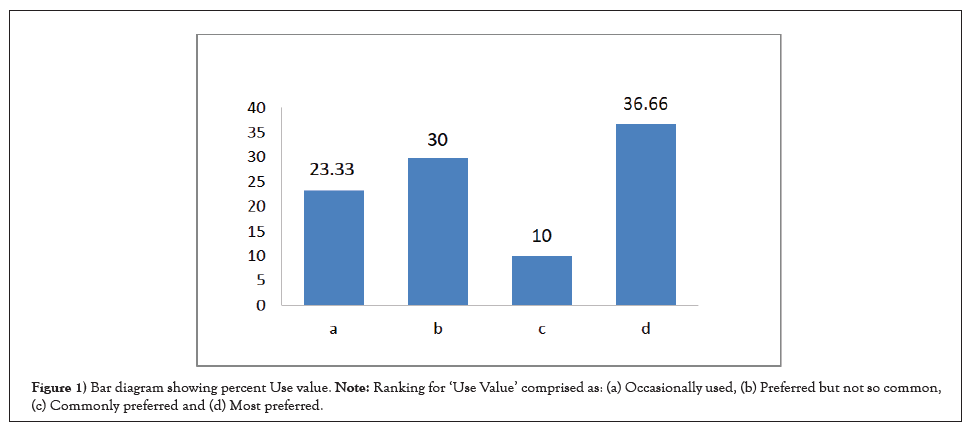
Figure 1: Bar diagram showing percent Use value. Note: Ranking for ‘Use Value’ comprised as: (a) Occasionally used, (b) Preferred but not so common, (c) Commonly preferred and (d) Most preferred.
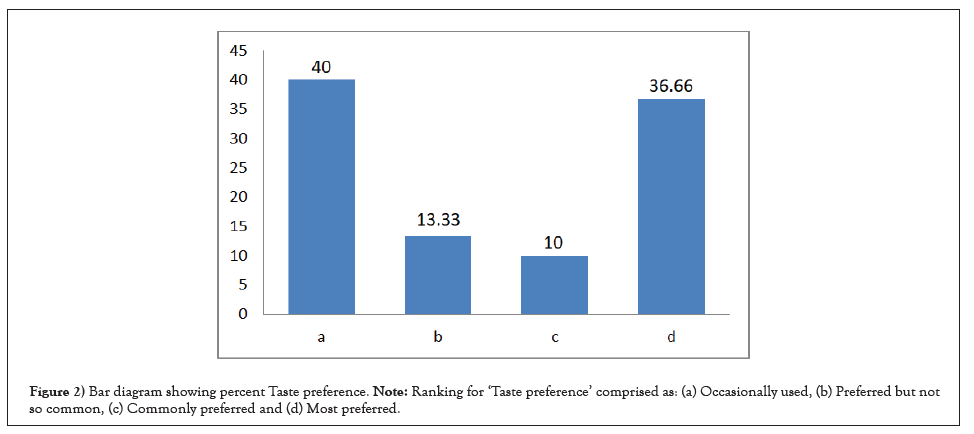
Figure 2: Bar diagram showing percent Taste preference. Note: Ranking for ‘Taste preference’ comprised as: (a) Occasionally used, (b) Preferred but not so common, (c) Commonly preferred and (d) Most preferred.
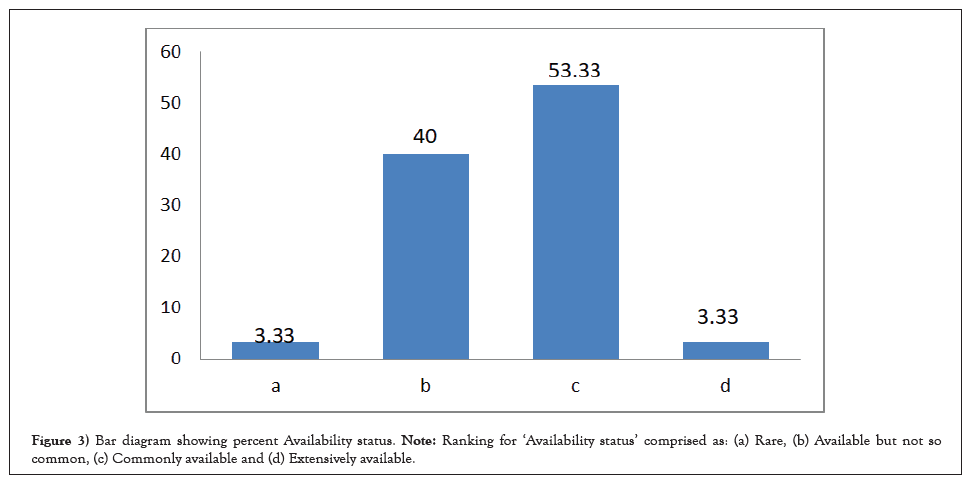
Figure 3: Bar diagram showing percent Availability status. Note: Ranking for ‘Availability status’ comprised as: (a) Rare, (b) Available but not so common, (c) Commonly available and (d) Extensively available.
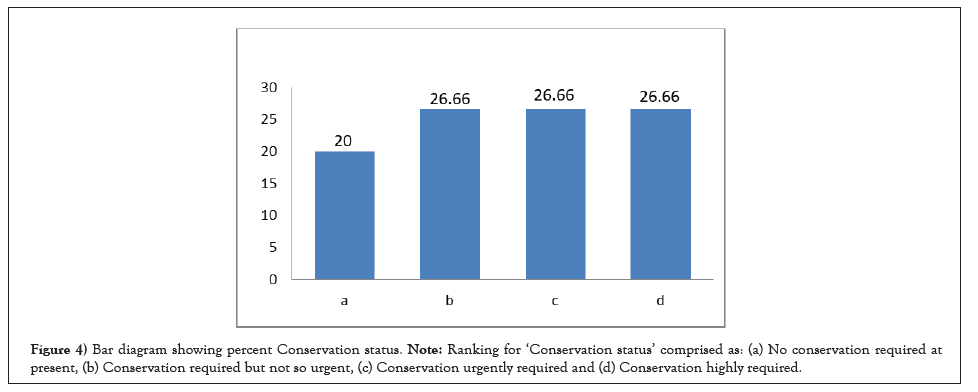
Figure 4: Bar diagram showing percent Conservation status. Note: Ranking for ‘Conservation status’ comprised as: (a) No conservation required at present, (b) Conservation required but not so urgent, (c) Conservation urgently required and (d) Conservation highly required.
| Botanical names | Local name | *Use status | Taste preference* | Availability status* | Conservation status* | Total score |
|---|---|---|---|---|---|---|
| Acorus calamus | Ok-hidak | 1 | 1 | 2 | 2 | 6 |
| Alocasia cuculata | Singjupan | 4 | 4 | 2 | 4 | 14 |
| Amaranthus spinosus | Chengkruk tingkhang panbi | 2 | 2 | 2 | 2 | 8 |
| Cyperus haspan | Kauthum | 3 | 4 | 2 | 3 | 4 |
| Enhydra fluctuans | Komprek tujombi | 3 | 3 | 2 | 3 | 11 |
| Equisetum debile | Lai utong | 1 | 1 | 2 | 2 | 6 |
| Eryngium foetidum | Awa-fadigom | 4 | 4 | 3 | 2 | 13 |
| Euryale ferox | Thangjing | 4 | 4 | 2 | 4 | 14 |
| Hedychium coronarium | Loklei | 4 | 4 | 3 | 4 | 15 |
| Hedyotis auricularia | Langban-koukha | 1 | 1 | 3 | 1 | 6 |
| Houttuynia cordata | Toningkhok | 4 | 4 | 3 | 3 | 14 |
| Hydrocotyle sibthorpioides | Lei/Lai-peruk | 1 | 1 | 2 | 2 | 6 |
| Ipomea aquatica | Kolamni | 3 | 3 | 3 | 2 | 11 |
| Jussiaea repens | Ising kundo | 1 | 1 | 3 | 1 | 6 |
| Leucas aspera | Mayang lembum | 1 | 1 | 3 | 1 | 6 |
| Marsilea minuta | Ishing-yensang | 1 | 1 | 4 | 1 | 7 |
| Nasturtium indicum | Uchi-hangam | 1 | 1 | 3 | 1 | 6 |
| Nelumbo nucifera | Thambal | 3 | 4 | 3 | 4 | 16 |
| Neptunia oleraceae | Eshing ikaithabi | 4 | 4 | 2 | 4 | 14 |
| Nymphaea stellata | Thariktha | 2 | 2 | 2 | 2 | 8 |
| Nymphoides indicum | Tharo-macha | 2 | 2 | 2 | 2 | 8 |
| Oenanthe javanica | Komprek | 4 | 4 | 2 | 3 | 13 |
| Plantago erosa | Yempat | 1 | 1 | 3 | 1 | 6 |
| Polygonum barbatum | Yelang | 3 | 3 | 2 | 3 | 11 |
| Polygonum perfoliatum | Lilhar | 1 | 1 | 3 | 1 | 6 |
| Polygonum posumba | Phakpai | 3 | 3 | 2 | 3 | 11 |
| Ranunculus scleratus | Kakyel-khujil | 1 | 1 | 2 | 1 | 5 |
| Sagittaria sagittifolia | Koukha | 3 | 4 | 2 | 3 | 12 |
| Trapa natans | Heikak yetli | 3 | 4 | 2 | 3 | 12 |
| Zizania latifolia | Eshing kambong | 3 | 4 | 3 | 4 | 14 |
Note: * The status of species in each category is rank in a scale of 4 to1 (Use and Taste status: 4-most preferred, 3-commonly preferred, 2-preferred but not so common, and 1-occassionally used; Availability status: 4-extensively available, 3-commonly available, 2-available but not so common, and 1-rare; Conservation status: 4-widely required, 3-normally required, 2-required but not so common, 1-not required at present).
Table 3: Community matrix ranking for aquatic plant species for use, taste, availability and conservation status in Manipur, India.
From the present study, 30 species belonging to 24 families have been identified. The collected aquatic plants are used in the healing of various diseases and ailments, viz. cough, fever, headache, wounds, ulcers, piles, diarrhea, dysentery, jaundice, eye and skin diseases, rheumatic pain, diabetes, hypertension, urinary troubles, muscular and body pain, respiratory problems, urinary problems, cardiovascular diseases, bleeding, constipation, fracture of bones, gonorrhea, smallpox, measles, snakebite, etc. They use it either orally, internally, or externally. To treat ailments such as stomach ache, headache, chronic ulcer, gastritis, and so on, the fresh leaf or part of the plant is used orally as a tonic or concoction, or as a culinary preparation, and externally in the form of ointment, paste, or balm for cases of cuts, burns, sprains, fractures, septicemia, and so on. The most frequent practice used for therapeutic purposes was to make a paste, decoction, or powder, or to boil or eat raw. From the survey, it was discovered that most of the diseases, viz., indigestion, dysentery, and intestinal infections (14 species); skin diseases (13 species); gout, muscular, and rheumatic sprains (12 species); blood pressure and circulation problems (12 species); cough and fever (10 species); urinary troubles (9 species); diabetes (9 species); boils, burns, and wounds (7 species); earache and insect bites (6 species); stomach ulcers (6 species); jaundice (5 species); cuts and injuries (4 species); cuts and injuries (4 species); piles (4 species); paralysis (3 species); intestinal worms, leucoderma; food poisoning and cancer (1 each species) were treated with locally available aquatic plants. Among plant parts used for medicinal purposes, leaves are the most commonly used (26%), followed by young shoots (20%), rhizomes (14%), and flowers and tubers (3%), as shown in Figure 5.
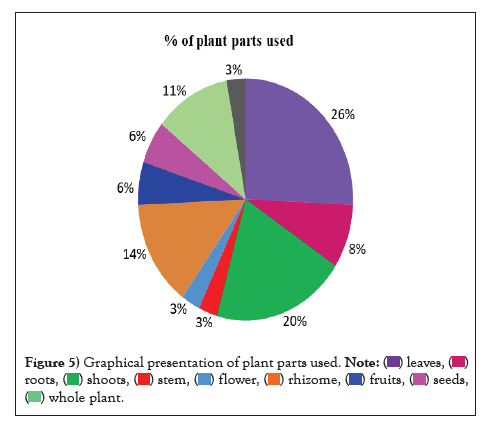
Figure 5: Graphical presentation of plant parts used. 



Rice is a staple food for the locals, along with green leafy vegetables and salad. The communities used diverse methods to devour these aquatic species. Their diet exclusively depends on the fresh green vegetables they eat. Consumption in the form of raw food was the most preferred mode to utilize the aquatic plants and was incorporated into the most commonly eaten traditional preparations such as ooti, eronba, singju, etc. Singju is the most prominent conventional food made by combining aquatic plants with fermented fish, chili, and other plants. Eronba is prepared by boiling plant parts and smashing them with potatoes, chili, and fermented fish, while ooti is prepared by boiling vegetables with a pinch of sodium bicarbonate (Table 1). At least one item in each feast was a crucial component of the local diets, which explained the significance of aquatic plants in the local system. Polygonum barbatum (yelang), Ipomea aquatica (Komlamni), Oenanthe javanica (Komprek), Neptunia oleracea (Ekaithabi), Eurgale fero (Thangjing), Trapa natans (Heikak), Marsilea minuta (Ising ensang), Nelumbo nucifera (Thambou), Nymphaea alba (Tharo) are some of the aquatic plants used for remedial purposes but also in the preparation of various traditional dishes, such as Eronba, Singju, Kangsoi, Chamthong, Paknam, Ooti, etc.
The most common ten aquatic plant species estimated for different mineral contents have been presented in Table 2. The maximum and minimum contents of iron were recorded in Jussiaea repens and Nelumbo nucifera; for magnesium in Trapan natas and Eleocharis dulcis; for calcium in Trapan natas and Eleocharis dulcis; and for zinc in Ipomea aquatica and Eleocharis dulcis, respectively. From Figure 6, we can conclude that 70% of the plants are marketable, and the remaining 30% are non-marketable. Besides, most of the aquatic plants grow wild and are available in abundance. Consequently, people generously collect them and provide a means of livelihood and a source of income specifically for the poor and landless. Among aquatic plants, Cyperus haspan, Euryale ferox, Ipomoea aquatica, Nelumbo nucifera, Neptunia oleraceae, Oenanthe javanica, Polygonum barbatum, Trapa natans, Sagittaria sagittifolia, Zizania latifolia, etc. are some of the common vegetables sold in the market of Manipur and Sagittaria sagittifolia, Nelumbo nucifera, Neptunia oleraceae, Zizania latifolia and Cyperus haspan are some of the delicacies and expensive conventional foods available in Manipur. Most of the rural population was drawn into the business, which primarily comprises women. Neptunia oleracea, Sagittaria sagittifolia and Zizania latifolia are some of the most demanding aquatic species, regardless of their inadequate availability, which could lead to their constricted scope of distribution and accessibility during the growing season only. Some of the species, viz., Euryale ferox, Colocasia esculenta, Oenanthe javanica, Nelumbo nucifera, Polygonum barbatum, Hedychium coronarium and Sagittaria sagittifolia, are also a way of generating income among the rural people. Above all, most of these plants are consumed uncooked with the belief that they obtain direct nutritional and medicinal benefit and are thus incorporated in various conventional dishes, viz., Eronba, Kangsoi, Chamfut, Ooti, Kangsu, Singju, Chagem-Pomba, etc.
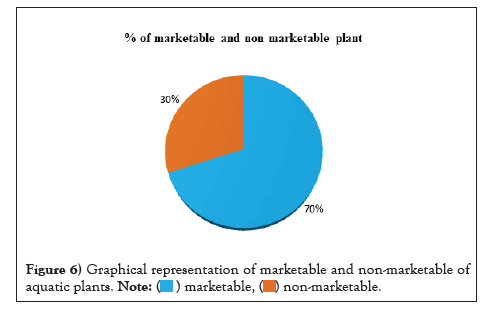
Figure 6: Graphical representation of marketable and non-marketable of
aquatic plants. 
Several wetlands are drying up as a result of climatic conditions and transforming into other landforms such as paddy fields, human settlements, land modification for development, and rainfall shift. It is suggested that a solidly participatory approach is necessary for the sustainable management of wetland areas. To accomplish the said objective, the community needs to be well-prepared for adopting sustainable harvest protocols for all the aquatic and wetland plants, and necessary training can be imparted for them. Additionally, appropriate value chain development for selling and value addition for aquatic plants can bring good revenue to communities. Thereby, soaring their income from them by improving their quality and developing by-products is very much necessary, as the majority of the species have a low self-life. Furthermore, aquatic plants can be grown in the fields by applying appropriate agro-techniques that will facilitate the management and conservation of aquatic plants in wetland areas. Therefore, emphasis on identification, documentation, assessment of the patterns, and validation of nutritional quality is crucial. In addition, the conservation of wetlands is becoming a globally discussed issue. Therefore, proper documentation and preservation of wetland plants help ensure sustainable, self-reliant socio-economic development of wetland areas by strengthening community linkages and acknowledging the aesthetic beauty of the place through ecotourism, etc. Furthermore, long-term perspectives can be obtained by approving sustainable harvesting of aquatic plants.
Interactions between researchers and local people have not only resulted in mutual understanding, but also in the oral transmission of traditional practices for the treatment of various disease ailments. Documentation and preservation of traditional knowledge are difficult tasks, but they can still be preserved for future pharmaceuticals and drug discovery through ongoing ethno botanical surveys and analyses of plants used by various ethnic communities. Therefore, a joint holistic approach between the researchers, NGOs, and local people is necessary for the conservation and protection of such valuable treasures to enlarge the population of the threatened wetland plants in their natural habitat.
O.A.D. and M.B.S. conceived and conceptualized the research idea, designed the experiments, interpreted the results, and prepared the manuscript. O.A.D. carried out purposive sampling for aquatic plants with relation to community dependence for subsistence and organized interview schedules. O.A.D. and M.B.S. carried out mineral analysis on commonly used aquatic species. S.S.N. helps in identifying the aquatic plants and participated in the design and coordination of the study. All authors read and approved the final manuscript.
The authors are pleased with the entire ethnic community of Imphal Valley for providing their valuable traditional knowledge and practices on aquatic plants found in wetland areas of Manipur. This paper would not have been possible without their kind-heartedness in sharing it with us. The authors are highly thankful to the Forest Department of Manipur for their constant help and support.
All data generated or analyzed during this study are included in this published research article.
The interviewees were informed about the objectives of the research study and the eventual publication of the information gathered, and they were assured that the informants ‘identities would remain undisclosed.
[Crossref] [Google Scholar] [Pubmed]
[Crossref] [Google Scholar] [Pubmed]
Citation: Devi OA, Saikia MB, Ningthoujam SS. Traditional usage of underutilized aquatic plants found in the Imphal valley of Manipur. AGBIR.2023; 39(1): 449-456.
Received: 16-Nov-2022, Manuscript No. AGBIR-22-79945; , Pre QC No. AGBIR-22-79945 (PQ); Editor assigned: 21-Nov-2022, Pre QC No. AGBIR-22-79945 (PQ); Reviewed: 13-Dec-2022, QC No. AGBIR-22-79945; Revised: 20-Dec-2022, Manuscript No. AGBIR-22-79945 (R); Published: 03-Jan-2023, DOI: 10.35248/0970-1907.23.39.449-456
Copyright: This open-access article is distributed under the terms of the Creative Commons Attribution Non-Commercial License (CC BY-NC) (http:// creativecommons.org/licenses/by-nc/4.0/), which permits reuse, distribution and reproduction of the article, provided that the original work is properly cited and the reuse is restricted to noncommercial purposes. For commercial reuse, contact reprints@pulsus.com This is an open access article distributed under the terms of the Creative Commons Attribution License, which permits unrestricted use, distribution, and reproduction in any medium, provided the original work is properly cited.
